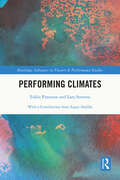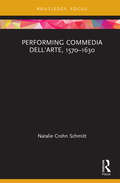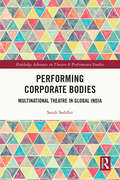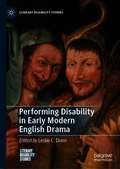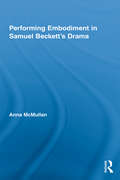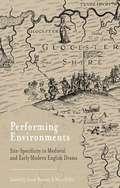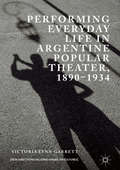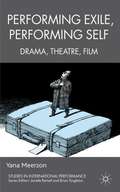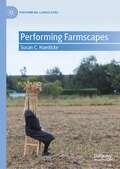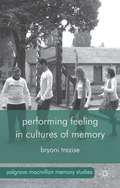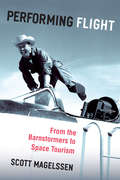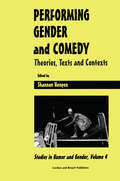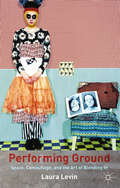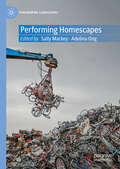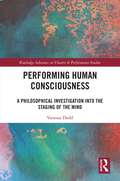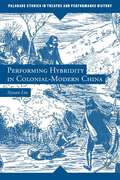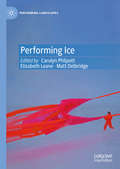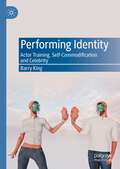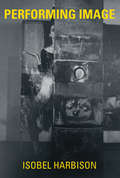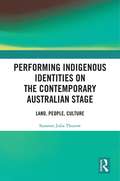- Table View
- List View
Performing Climates (Routledge Advances in Theatre & Performance Studies)
by Eddie Paterson Lara StevensPerforming Climates features 13 interconnected essays exploring theatre and performance’s relationship with more-than-human elements at a time of climate emergency. This book argues that Western performance – how we conceive of it, as well as how we train and educate people in and about it – needs to reorient its ways of making and thinking about itself to reconsider patterns of breakdown, decay and renewal happening on and off stage in a literal play of cells and particles. Performing Climates examines live performance as a uniquely compostable artform, formed by sonic vibrations and movements of air and matter, more-than-human elements, composition and decomposition. This book will appeal to undergraduate audiences, postgraduate scholars and performance studies colleagues, offering exciting possibilities for reconsidering theatre and performing in an age of crisis.
Performing Commedia dell'Arte, 1570-1630
by Natalie Crohn SchmittPerforming Commedia dell’Arte, 1570-1630 explores the performance techniques employed in commedia dell’arte and the ways in which they served to rapidly spread the ideas that were to form the basis of modern theatre throughout Europe. Chapters include one on why, what, and how actors improvised, one on acting styles, including dialects, voice and gesture; and one on masks and their uses and importance. These chapters on historical performance are followed by a coda on commedia dell’arte today. Together they offer readers a look at both past and present iterations of these performances. Suitable for both scholars and performers, Performing Commedia dell’Arte, 1570-1630 bears on essential questions about the techniques of performance and their utility for this important theatrical form.
Performing Consumers: Global Capital and its Theatrical Seductions
by Maurya WickstromPerforming Consumers is an exploration of the way in which brands insinuate themselves into the lives of ordinary people who encounter them at branded superstores. Looking at our performative desire to ‘try on’ otherness, Maurya Wickstrom employs five American brandscapes to serve as case studies: Ralph Lauren; Niketown; American Girl Place; Disney store and The Lion King; and The Forum Shops at Caesar’s Palace in Las Vegas. In this post-product era, each builds for the performer/consumer an intensely pleasurable, somatic experience of merging into the brand and reappearing as the brand, or the brand’s fictional meanings. To understand this embodiment as the way that capital is producing subjectivity as an aspect of itself, Wickstrom casts a wide net, drawing on: the history of capital’s relationship with theatre political developments in the United States recent work in political science, philosophy, and performance studies. An adventurous study of theatrical indeterminancy and material culture, Performing Consumers brilliantly takes corporate culture to task.
Performing Corporate Bodies: Multinational Theatre in Global India (Routledge Advances in Theatre & Performance Studies)
by Sarah SaddlerThis book offers the first look at corporate theatre, a global management trend that uses dramatic techniques in workplace learning.Drawing on a decade of research with artists, consultancies, drama schools, and multinational firms in India and across the Global South, Sarah Saddler provides a fascinating perspective on why theatre and performance are finding new legitimacy in corporate economies under late capitalism. Chapters spotlight how theatre is wielded by management to advance urgent corporate agendas, while examining corporate theatre’s impact on broader social transformations, such as the theatrical dimensions of management and shifting creative horizons for performance practitioners. Through vivid vignettes, Sarah Saddler argues that corporate theatre has become a mode of physical and psychological conditioning used to encode the cultural dimensions of global capitalism. Simultaneously, she uncovers how corporate theatre employs humor tactics that enable individuals to navigate systems of power, becomes a remedy for corporations grappling with the crushing competition of capitalism, and offers a critical perspective on artistic agency within the creative economy.This book will be of interest to readers across the interdisciplinary humanities including theatre and performance studies, anthropology, sociology, and South Asian studies.
Performing Disability in Early Modern English Drama (Literary Disability Studies)
by Leslie C. DunnPerforming Disability in Early Modern English Drama investigates the cultural work done by early modern theatrical performances of disability. Proffering an expansive view of early modern disability in performance, the contributors suggest methodologies for finding and interpreting it in unexpected contexts. The volume also includes essays on disabled actors whose performances are changing the meanings of disability in Shakespeare for present-day audiences. By combining these two areas of scholarship, this text makes a unique intervention in early modern studies and disability studies alike. Ultimately, the volume generates a conversation that locates and theorizes the staging of particular disabilities within their historical and literary contexts while considering continuity and change in the performance of disability between the early modern period and our own.
Performing Electronic Music Live (Audio Engineering Society Presents)
by Kirsten HermesPerforming Electronic Music Live lays out conceptual approaches, tools, and techniques for electronic music performance, from DJing, DAWs, MIDI controllers, traditional instruments, live sound design, hardware setups, custom software and hardware, to live visuals, venue acoustics, and live show promotion. Through case studies and contrasting tutorials by successful artists, Kirsten Hermes explores the many different ways in which you can create memorable experiences on stage. Featuring interviews with highly accomplished musicians and practitioners, readers can also expand on their knowledge with hands-on video tutorials for each chapter via the companion website, performingelectronicmusic.live. Performing Electronic Music Live is an essential, all-encompassing resource for professionals, students of music production courses, and researchers in the field of creative-focused performance technology.
Performing Embodiment in Samuel Beckett's Drama (Routledge Advances In Theatre And Performance Studies #12)
by Anna McMullanThe representation and experience of embodiment is a central preoccupation of Samuel Beckett’s drama, one that he explored through diverse media. McMullan investigates the full range of Beckett’s dramatic canon for stage, radio, television and film, including early drama, mimes and unpublished fragments. She examines how Beckett’s drama composes and recomposes the body in each medium, and provokes ways of perceiving, conceiving and experiencing embodiment that address wider preoccupations with corporeality, technology and systems of power. McMullan argues that the body in Beckett’s drama reveals a radical vulnerability of the flesh, questioning corporeal norms based on perfectible, autonomous or invulnerable bodies, but is also the site of a continual reworking of the self, and of the boundaries between self and other. Beckett’s re-imagining of the body presents embodiment as a collaborative performance between past and present, flesh and imagination, self and other, including the spectator / listener.
Performing Environments
by Susan Bennett Mary PolitoThis ground-breaking collection explores the assumptions behind and practices for performance implicit in the manuscripts and playtexts of the medieval and early modern eras, focusing on work which engages with performance-oriented research.
Performing Everyday Life in Argentine Popular Theater, 1890–1934 (New Directions In Latino American Cultures Ser.)
by Victoria Lynn GarrettThis book examines the prolific and widely-attended popular theater boom of the género chico criollo in the context of Argentina’s modernization. Victoria Lynn Garrett examines how selected plays mediated the impact of economic liberalism, technological changes, new competing and contradictory gender roles, intense labor union activity, and the foreign/nativist dichotomy. Popular theaters served as spaces for cultural agency by portraying conventional and innovative performances of daily life. This dramatic corpus was a critical mass cultural medium that allowed audiences to evaluate the dominant fictions of liberal modernity, to critique Argentina’s purportedly democratic culture, and to imagine alternative performances of everyday life in accordance with their realities. Through a fresh look at the relationship among politics, economics, popular culture, and performance in Argentina’s modernization period, the book uncovers largely overlooked articulations of popular-class identities and desires for greater inclusion that would drive social and political struggles to this day.
Performing Exile, Performing Self
by Yana MeerzonThis book examines the life and art of those contemporary artists who by force or by choice find themselves on other shores. It argues that the exilic challenge enables the #65533;migr#65533; artist to (re)establish new artistic devices, new laws and a new language of communication in both his everyday life and his artistic work.
Performing Farmscapes (Performing Landscapes)
by Susan C. HaedickeThis book argues that the performance-based work in the featured case studies contributes to the construction of food democracy where the public takes back decision-making in shaping the food system. It explores how contemporary artists translate scientific research about local and global agricultural issues into life stories that inform and engage their audiences and, in so doing, transform passive food consumers into proactive food citizens. The pairing of performing and farmscapes (complex webs of farmlands and storylines) enables artists to use embodied practices to encourage audiences to imagine a just and sustainable agri-food system and to collaborate on making it a reality. The book arranges the case studies on a trajectory that moves from projects that foreground knowledge acquisition to ones that emphasize social engagement by creating conversations and coalitions between farming and nonfarming communities to a final one that pairs protest art and political activism to achieve legally-binding changes in the agricultural landscape.
Performing Feeling in Cultures of Memory
by Bryoni TrezisePerforming Feeling in Cultures of Memory brings memory studies into conversation with a focus on feelings as cultural actors. It charts a series of memory sites that range from canonical museums and memorials, to practices enabled by the virtual terrain of Second Life, popular 'trauma TV' programs and radical theatre practice.
Performing Flight: From the Barnstormers to Space Tourism
by Scott MagelssenPerforming Flight sheds new light on moments in the history of US aviation and spaceflight through the lens of performance studies. From pioneering aviator Bessie Coleman to the emerging industry of space tourism, performance has consistently shaped public perception of the enterprise of flight and has guaranteed its success as a mode of entertainment, travel, research, and warfare. The book reveals fundamental connections between performance and human aviation and space travel over the past 100 years, beginning with the early aerial entertainers known as barnstormers (named after itinerant 19th century theater troupes) to the performative history of the Enola Gay and its pilot Paul Tibbets, who dropped the bomb on Hiroshima, thus ushering in the atomic age. The book also explores the phenomenon of “the pilot voice”; the creation of the American Astronaut, on whose performative success the Cold War, the Space Race, and funding of the US Space Program all depended; and the performative strategies employed to cement notions of space tourism as both manifest destiny and an escape route from a failed planet. A final chapter addresses the four hijacked flights of 9/11 and their representations in discourse and in memorials. Performing Flight effectively and imaginatively demonstrates the ways in which performance and flight in the United States have been inextricably linked for more than a century.
Performing Gender and Comedy: Theories, Texts and Contexts
by Hengen SFirst Published in 1998. Routledge is an imprint of Taylor & Francis, an informa company.
Performing Greek Comedy
by Alan HughesAlan Hughes presents a new complete account of production methods in Greek comedy. The book summarizes contemporary research and disputes, on such topics as acting techniques, theater buildings, masks and costumes, music and the chorus. Evidence is re-interpreted and traditional doctrine overthrown. Comedy is presented as the pan-Hellenic, visual art of theater, not as Athenian literature. Recent discoveries in visual evidence are used to stimulate significant historical revisions. The author has directly examined 350 vase scenes of comedy in performance and actor-figurines, in 75 collections, from Melbourne to St Petersburg. Their testimony is applied to acting techniques and costumes, and women's participation in comedy and mime. The chapters are arranged by topic, for convenient reference by scholars and students of theater history, literature, classics and drama. Overall, the book provides a fresh practical insight into this continually developing subject.
Performing Ground
by Laura LevinPerforming Ground explores camouflage as a performance practice, arguing that the act of blending into one's environment is central to the ways we negotiate our identities through space. The book offers a critically rich investigation of how the performative practice of camouflage renders the politics of space, power, and gender (in)visible.
Performing Home (Routledge Advances in Theatre & Performance Studies)
by Stuart AndrewsPerforming Home is the first sustained study of the ways in which artists create artworks in, and in response to, domestic dwellings. In the context of growing interest in ideas and practices that cross between architecture, arts practice and performance, it is valuable to understand what happens when artists make work in and about specific buildings. This is particularly important with domestic dwellings, which can be bound up with experiences, issues, practices and understandings of home. The book focuses on a range of recent artistic projects to identify and investigate critical ways by which artists practise domestic dwellings. In doing so, it addresses the ways in which artists enquire into a dwelling, are resident in a dwelling, adapt the form of a dwelling, practise a mobile dwelling, and make a dwelling. By considering these practices together, Andrews demonstrates the breadth and significance of recent artistic engagement in and with domestic dwellings, and highlights the contribution that artistic practice can make to the ways in which we understand the form and practice of a building. Performing Home will be of particular relevance to scholars, students and practitioners in architecture, art and performance, to those in geography, material culture and cultural studies, and to anyone seeking to make sense of the place in which they live.
Performing Homescapes (Performing Landscapes)
by Sally Mackey Adelina OngPart of the Performing Landscapes series, Performing Homescapes is an edited collection comprising a contemporary exploration of performing many iterations of landscapes of homes. Authors were invited to respond to a detailed brief with home to be deliberately reconsidered as homescape, represented by landscapes, sites and practices often outside, and occasionally including a conventional home-as-house and intimate dwelling. We wanted a diverse range of geographical sites to be represented and a global offer, encompassing a pluriverse of homescapes. Voices, practices, and epistemologies from the Global South and global majority were important to us, including Indigenous ways of knowing and practicing. This curated collection offers an expanded understanding of the performance of home/scapes as a new intervention into the fields of performance and home scholarship. Performing Homescapes moves beyond spatial meditations within rooms of a house to offer an original critical engagement with the social, political, ecological and cultural landscapes that shape and sustain affects related to the notion of home, unhomeliness and, even, solastalgia. While the impact of the social, political and cultural landscapes on relationships with - and within - the house are implied in most academic literature on forms of performing home, it is foregrounded in the chapters of this edited collection. In addition, certain chapters attend to the more-than-human, human relationships with the Earth as homescape and the co-creation of homescapes within and beyond dwellings.
Performing Human Consciousness: A Philosophical Investigation into the Staging of the Mind (ISSN)
by Vanessa DoddIs the mind like a theatrical performance? This comparison has often been used as a conceptual tool by neuroscientists, philosophers, and psychologists in trying to understand what constitutes the human mind, and in particular how the comings and goings and the character transformations on the stage and in the scripted text give us visible access to the hidden workings of the human mind.Performing Human Consciousness makes use of this metaphor to explore the variety of ways in which the private thoughts and feelings we all have bring into play many aspects of persistent philosophical questions over how the essentially private world of personal experiences can relate to and communicate with the common public world. To investigate this generalisation in more detail, the author brings into play her own conscious experiences by making use of an auto-inscribed play Being Me. Through this dramatic medium she seeks to show in detail how phenomenal consciousness is captured through the dramatic play text and thereby made known to others through performance of that text. Broadening out her argument further, the author then embarks on an enquiry into a selection of play texts from an historical variety of perspectives, from the early Greek and Mediaeval dramas, through to the Symbolist period and onwards to the present day, demonstrating the variety of ways in which they illustrate her argument. This book will be of great interest to students and scholars of theatre & performance and scriptwriting.
Performing Human Rights: Artistic Interventions into European Asylum (Routledge Series in Equity, Diversity, and Inclusion in Theatre and Performance)
by Anika MarschallThis book enhances critical perspectives on human rights through the lens of performance studies and argues that contemporary artistic interventions can contribute to our understanding of human rights as a critical and embodied doing. This study is situated in the contemporary discourse of asylum and political art practices. It argues for the need to reimagine human rights as performative and embodied forms of recognition and practical honouring of our shared vulnerability and co-dependency. It contributes to the debate of theatre and migration, by understanding that contemporary asylum issues are complex and context specific, and that they do not only pertain to the refugee, migrant, asylum seeker or stateless person but also to privileged constituencies, institutional structures, forms of organisation and assembly. The book presents a unique mixed-methods approach that focuses equally on performance analyses and on political philosophy, critical legal studies and art history – and thus speaks to a range of politically interested scholars in all four fields.
Performing Hybridity in Colonial-Modern China
by Siyuan LiuIn Shanghai in the early twentieth century, a hybrid theatrical form, wenmingxi, emerged that was based on Western spoken theatre, classical Chinese theatre, and a Japanese hybrid form known as shinpa. This book places it in the context of its hybridized literary and performance elements, giving it a definitive place in modern Chinese theatre.
Performing Ice (Performing Landscapes)
by Elizabeth Leane Matt Delbridge Carolyn PhilpottIn the Anthropocene, icy environments have taken on a new centrality and emotional valency. This book examines the diverse ways in which ice and humans have performed with and alongside each other over the last few centuries, so as to better understand our entangled futures. Icescapes – glaciers, bergs, floes, ice shelves – are places of paradox. Solid and weighty, they are nonetheless always on the move, unstable, untrustworthy, liable to collapse, overturn, or melt. Icescapes have featured – indeed, starred – in conventional theatrical performances since at least the eighteenth century. More recently, the performing arts – site-specific or otherwise – have provoked a different set of considerations of human interactions with these non-human objects, particularly as concerns over anthropogenic warming have mounted. The performances analysed in the book range from the theatrical to the everyday, from the historical to the contemporary, from low-latitude events in interior spaces to embodied encounters with the frozen environment.
Performing Identity: Actor Training, Self-Commodification and Celebrity
by Barry KingThis book examines how the persistent and deepening casualization and precarity of acting work, coupled with market pressures, has affected the ways in which actors are trained in the US and UK. It reviews the existing state of training, looking at various theories of what the actor does, debates about casting, and the impact of reality television and social media. In the increasing effort to find ways to overcome the precarious labour market for actors and other performers, the traditional emphasis on theatrical character has been replaced by the celebration of the persona – a public image of the performer as a personal brand. As a result, a physiocratic elite, that literally incorporates the collective labour of cultural workers into the star or celebrity body, has formed. This book explores how the star or celebrity’s appearance and comportment are positioned as the rule of nature, formed and abiding outside capitalism as a mode of production. This book will be of interest to those studying theatre studies and performance, contemporary stardom and celebrity and the impact of technology on the formation of identity.
Performing Image (The\mit Press Ser.)
by Isobel HarbisonAn examination of how artists have combined performance and moving image for decades, anticipating our changing relation to images in the internet era.In Performing Image, Isobel Harbison examines how artists have combined performance and moving image in their work since the 1960s, and how this work anticipates our changing relations to images since the advent of smart phones and the spread of online prosumerism. Over this period, artists have used a variety of DIY modes of self-imaging and circulation—from home video to social media—suggesting how and why Western subjects might seek alternative platforms for self-expression and self-representation. In the course of her argument, Harbison offers close analyses of works by such artists as Robert Rauschenberg, Yvonne Rainer, Mark Leckey, Wu Tsang, and Martine Syms.Harbison argues that while we produce images, images also produce us—those that we take and share, those that we see and assimilate through mass media and social media, those that we encounter in museums and galleries. Although all the artists she examines express their relation to images uniquely, they also offer a vantage point on today's productive-consumptive image circuits in which billions of us are caught. This unregulated, all-encompassing image performativity, Harbison writes, puts us to work, for free, in the service of global corporate expansion. Harbison offers a three-part interpretive framework for understanding this new proximity to images as it is negotiated by these artworks, a detailed outline of a set of connected practices—and a declaration of the value of art in an economy of attention and a crisis of representation.
Performing Indigenous Identities on the Contemporary Australian Stage: Land, People, Culture
by Susanne Julia ThurowOver the past 50 years, Indigenous Australian theatre practice has emerged as a dynamic site for the discursive reflection of culture and tradition as well as colonial legacies, leveraging the power of storytelling to create and advocate contemporary fluid conceptions of Indigeneity. Performing Indigenous Identities on the Contemporary Australian Stage offers a window into the history and diversity of this vigorous practice. It introduces the reader to cornerstones of Indigenous Australian cultural frameworks and on this backdrop discusses a wealth of plays in light of their responses to contemporary Australian identity politics. The in-depth readings of two landmark theatre productions, Scott Rankin’s Namatjira (2010) and Wesley Enoch & Anita Heiss’ I Am Eora (2012), trace the artists’ engagement with questions of community consolidation and national reconciliation, carefully considering the implications of their propositions for identity work arising from the translation of traditional ontologies into contemporary orientations. The analyses of the dramatic texts are incrementally enriched by a dense reflection of the production and reception contexts of the plays, providing an expanded framework for the critical consideration of contemporary postcolonial theatre practice that allows for a well-founded appreciation of the strengths yet also pointing to the limitations of current representative approaches on the Australian mainstage. This study will be of great interest to students and scholars of Postcolonial, Literary, Performance and Theatre Studies.
